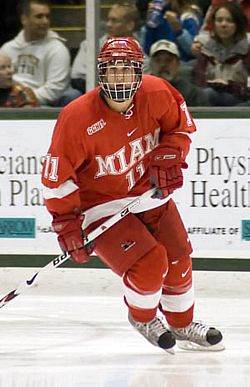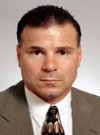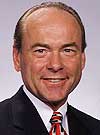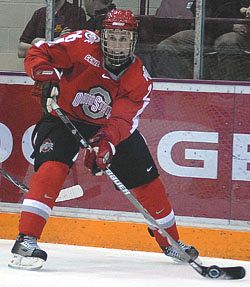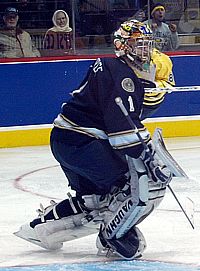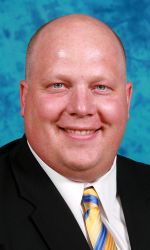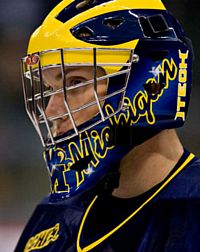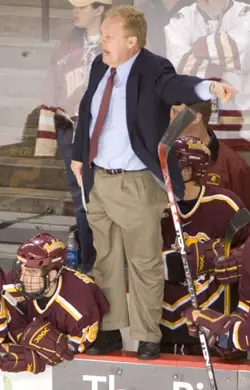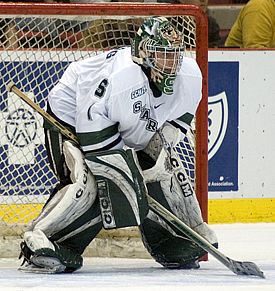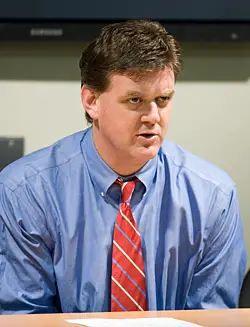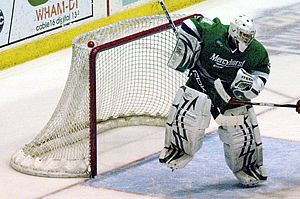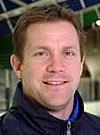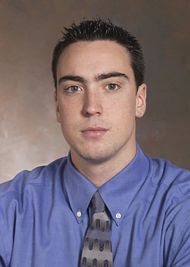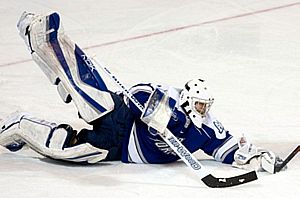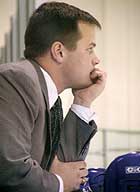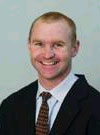The 2008-09 CCHA: A Numbers Game
“Coincidence,” says science fiction and fantasy writer Emma Bull, “is the word we use when we can’t see the levers and pulleys.”
On April 12, 2008, the Fighting Irish of Notre Dame played the Eagles of Boston College for the NCAA men’s ice hockey championship. Notre Dame was the fourth-place CCHA team for the 2007-08 season.
On April 7, 2007, it was the Michigan State Spartans who faced Boston College in the national title game. The Spartans finished fourth in the CCHA in 2006-07.
All right. So the Irish didn’t actually win their match against the Eagles one year and six days after MSU defeated BC to give the CCHA its first national championship since Michigan beat Boston College in 1998.
And I’m sure that my colleagues Jim Connelly and Dave Hendrickson will be all blahbitty-blah all season long about the fact that Boston College won this time. Yada, yada, yada. Whatever.

Red Berenson’s Wolverines are the co-favorites, along with Notre Dame, in the CCHA (photo: Melissa Wade).
The fact remains that for the second consecutive year, the CCHA sent its fourth-place team to a national championship game — and sports prognostication is all about the facts. (Like that little stat about BC appearing in three consecutive title games. I’m sure that must mean something, but I can’t quite put my finger on it.)
While the league finish of the last two CCHA national contenders may be coincidental, the league did send a team to the title game for two years running — and sent two different teams to that match, and three different CCHA teams have made Frozen Four appearances in the last two seasons.
That has to count for something.
In the 2007-08 NCAA tournament, all four CCHA teams to receive a bid — Miami, Michigan, Michigan State, and Notre Dame — advanced past the first round. The CCHA’s record in the NCAA tourney last year was 7-4, technically. Notre Dame eliminated Michigan State in the West Regional, and the Irish finished the Wolverines at the Frozen Four.
In 2006-07, the CCHA was 6-2 in NCAA tournament play (and MSU took out ND in the Midwest Regional). That’s a record of 13-6 in the past two postseasons. Compare that to the dismal league showings from 2004-2006 in NCAA tournament play (3-11), and there are your levers and pulleys.
“Ferris State, Northern Michigan, Ohio State — just the consistency of the improvement in our league and I think that our conference will be the most elite conference in college hockey this year,” says Notre Dame head coach Jeff Jackson. “I think that any one of the chosen top six teams could finish first and it wouldn’t be a surprise.”
If that were any coach other than Jackson, that might sound a little glib. But coming from a man who brought his team to the NCAA championship game in his third year as head coach, that carries some weight.
Or — maybe — Notre Dame is a sleeping giant that has awakened and only to add another perennial powerhouse to a rather predictable league.
Two Plus Two
There are two changes that have nothing to do with the way last season ended for the CCHA that will impact the league in yet undetermined ways.
The first is the addition of the second referee, which of course affects all of college hockey. The rationale here is that rules will be better enforced, the game will be better controlled, and each league will have a better chance to develop new referees.
Ohio State head coach John Markell welcomes this change. “It will help to clean up the game,” says Markell, who adds that certain unwanted behaviors “have crept back in” in recent seasons.
Jackson, however, has his reservations. “We tried that a long time ago and it only took us a year to move back to a one-man system.”
Every league will be making adjustments to this, but there’s a belief among fans in the CCHA — justified or no — that this league spearheads rules enforcement to such an extent that it takes half a season to make the necessary on-ice adjustments, and half a season to see real consistency in the way the new rules are enforced.
The Big One
The second major change is the addition of the shootout to decide overtime contests.
“I think the shootout is exciting,” says Michigan State head coach Rick Comley. “I think we need to eliminate ties.”
The NCAA gave leagues the opportunity to use a shootout to determine the winners of contests this season, and it should come as no surprise that the CCHA jumped on this immediately. This is a league unafraid of pioneering change in college hockey. This is also a league that has seen 90 regular-season games end in ties since the 2005.
When the league announced in August that it would go to the new shootout format, CCHA Commissioner Tom Anastos said, “The drama it creates is very popular with fans and, importantly, today’s players love it.”
Sure, if they play for Miami or Michigan. Not so much, perhaps, if they’re Broncos or Nanooks.
It’s an NHL-style, three-player shootout. The teams will play a regular five-minute sudden death before going to OT, and the games will be considered as ties for purposes of NCAA tournament selection. And just like the NHL, if a team wins in regulation or overtime, it earns two points. Both teams that tie at the end of 65 minutes of play will earn a point, with the shootout winner earning an additional point, all of which will affect the league’s standings.
“I’m in favor of moving the game forward, trying to make it better, and generate a little bit of an up-tempo game,” says Jackson.
“I think it’s a heck of a way to lose a hockey game,” says Markell.
Quick to jump on the shootout bandwagon was Greg Hammaren, the vice president and GM of FSN Detroit. “This is a bold move and I think it’s a great one,” said Hammaren. FSN will televise 17 regular-season and postseason CCHA contests in 2008-09.
And that is no coincidence.
Four Never Looked Better
While the two-ref system and the new shootouts will undoubtedly impact the 2008-09 CCHA season in yet unpredictable ways, there’s one thing that everyone can count on: Northern Michigan will be playing for a national championship!
Um, that is, if Miami doesn’t head to the title game.
You see, the Wildcats were picked fourth in the CCHA preseason coaches poll, while the RedHawks were tabbed for fourth place by the media. Given the last two NCAA tournaments, one of these teams will be playing Boston College for the national championship in April.
Positively.
Of course, noted mathematician John Allen Paulos might say something completely different about the ascension of fourth-place teams from the CCHA to the NCAA championship game in two consecutive years. Writes Paulos, “A tendency to drastically underestimate the frequency of coincidence is a prime characteristic of innumerates, who generally accord great significance to correspondence of all sorts while attributing too little significance to quite conclusive but less flashy statistical evidence.”
Hey! Our fourth-place team can beat your anyplace team. Probably. Maybe. And as long as you’re not affiliated with Hockey East.
And who’s he calling an innumerate, anyway?
Here’s a look at each team, in my predicted order of finish. Individual team previews can be accessed by clicking on each team’s name.
Do not take these to Vegas.
1. Michigan
Head coach: Red Berenson
2007-08 record: 33-6-4, 20-4-4 CCHA
2007-08 CCHA finish: first
2008-09 predicted ceiling/basement: first/second
Necessary repetition: “I never thought I’d be here for 25 years,” says Red Berenson. Given the consistent excellence Berenson’s been able to establish in Ann Arbor, there are probably 11 other guys in the league who would love to attend his retirement party.
2. Notre Dame
Head coach: Jeff Jackson
2007-08 record: 27-16-4, 15-9-4 CCHA
2007-08 CCHA finish: fourth
2008-09 predicted ceiling/basement: first/fourth
Necessary repetition: “We only scored one goal against Boston College in the championship game,” says Jeff Jackson, emphasizing his team’s need to produce offensively when it counts — and it always counts.
3. Michigan State
Head coach: Rick Comley
2007-08 record: 25-12-5, 19-6-3 CCHA
2007-08 CCHA finish: third
2008-09 predicted ceiling/basement: first/fourth
Necessary repetition: “I think you enjoy coaching young teams because they’re very enthusiastic,” says Rick Comley. With 11 freshmen on the roster, that’s a lot of enthusiasm.
4. Miami
Head coach: Enrico Blasi
2007-08 record: 33-8-1, 21-6-1 CCHA
2007-08 CCHA finish: second
2008-09 predicted ceiling/basement: first/fourth
Necessary repetition: “We feel real good about our team,” says Enrico Blasi, the CCHA’s new master of understatement. Sure, the RedHawks parted ways with highlight-reel players, but the gents who remain are very photogenic.
5. Northern Michigan
Head coach: Walt Kyle
2007-08 record: 20-20-4, 12-13-3 CCHA
2007-08 CCHA finish: sixth
2008-09 predicted ceiling/basement: fifth/eighth
Necessary repetition: “I’m happy with our group,” says Walt Kyle. Why wouldn’t he be? With nothing riding on his young Wildcats last season, NMU returned to Joe Louis Arena to lay a solid foundation for this season.
6. Ferris State
Head coach: Bob Daniels
2007-08 record: 18-16-5, 12-12-4 CCHA
2007-08 CCHA finish: fifth
2008-09 predicted ceiling/basement: fifth/eighth
Necessary repetition: “We only have four returning defensemen,” says Bob Daniels. With Pat Nagle in net, though, this may not be an issue — and defense never seems to be the problem for the Bulldogs, anyway.
7. Nebraska-Omaha
Head coach: Mike Kemp
2007-08 record: 17-19-4, 11-13-4 CCHA
2007-08 CCHA finish: eighth
2008-09 predicted ceiling/basement: fifth/eighth
Necessary repetition: “The real key to our success on the road last year was team unity,” says Mike Kemp, whose Mavericks played as evenly away from Omaha as they did at home. Chemistry is nice, but finding players to score 50 goals lost from last season would be even nicer.
8. Ohio State
Head coach: John Markell
2007-08 record: 12-25-4, 7-18-3 CCHA
2007-08 CCHA finish: 11th
2008-09 predicted ceiling/basement: sixth/10th
Necessary repetition: “As far as our cluster, I think this is a 12-team cluster,” says John Markell. That’s a very healthy approach to being perennially paired with Miami and being clustered with Michigan and Michigan State this season.
9. Bowling Green
Head coach: Scott Paluch
2007-08 record: 18-21-0, 13-15-0 CCHA
2007-08 CCHA finish: seventh
2008-09 predicted ceiling/basement: sixth/10th
Necessary repetition: “I think it’s going to be a challenging cluster,” says Scott Paluch, whose Falcons are perennially paired with new superpower, Notre Dame. Add NMU and LSSU to that mix — and miles and miles and miles.
10. Alaska
Head coach: Dallas Ferguson
2007-08 record: 9-21-5, 8-16-4 CCHA
2007-08 CCHA finish: ninth
2008-09 predicted ceiling/basement: seventh/12th
Necessary repetition: “I think what’s important,” says first-year head coach Dallas Ferguson, “is our identity of Nanook hockey and what it’s been.” Given that Ferguson is the third head coach in three years, that is a very interesting statement indeed.
11. Lake Superior
Head coach: Jim Roque
2007-08 record: 10-20-7, 7-15-6 CCHA
2007-08 CCHA finish: 10th
2008-09 predicted ceiling/basement: seventh/12th
Necessary repetition: “We hope to have a much better start this year and get back to Joe Louis,” says Jim Roque, whose Lakers were 2-11-3 in the first half of the 2007-08 season.
12. Western Michigan
Head coach: Jim Culhane
2007-08 record: 8-27-3, 4-22-2 CCHA
2007-08 CCHA finish: 12th
2008-09 predicted ceiling/basement: ninth/12th
Necessary repetition: “Goal scoring for us at times last year was difficult,” says Jim Culhane. With the 53rd-best offense in the nation in 2007-08, that’s no understatement.
